BY LORI MURRAY
I have never had any luck growing begonias. Just like my attempts at periwinkles, my attempts with the waxy beauties have failed miserably. But now there is hope! After three years of trials around the state, A&M Agrilife horticulturists named the Whopper Begonia a Texas Superstar for 2016. That designation means these plants will perform well and, because they are easy to propagate, be reasonably priced. They have larger foliage and larger flowers and are better able to tolerate heat and even direct sun.
The enormous flowers sit well above the foliage and make a showy display, thus living up to their name. They do extremely well in shade and partial shade and will tolerate full sun except in extreme heat, especially in regions with lower humidity, so those of us here in LRG Valley would be best keeping our beds in the shade. They have both green and brown foliage and are available with both red and rose flowers. They are even somewhat resistant to pests and disease.
While Whoppers planted in shade can reach 24 – 30 inches tall with a 12 – 16 inch spread, they will be shorter and more compact in the sun.
If you expose them to the sun, consider a bed with only morning exposure.Small plants can be spaced 8 – 10 inches apart for quicker fill, but larger plants (6 inch to gallon size) can be spaced 12 – 14 inches apart.
As always, a well-prepared bed with organic matter and good drainage is best, but the Whopper will tolerate a variety of soils.
The plants will handle the sun better if they are established before the summer heat, so if you plant near midsummer, it’s best to choose a shady location.
Keep the plants damp but not too wet because overwatering will cause crown rot. David Rodriguez, a horticulturist in Bexar County who serves on the Superstar Board, recommended using a peat- based potting mix in containers that drain well and applying generous amounts of slow-release fertilizer. He also noted that the plants could dry down a bit and would still recover from the wilt, and said that although the Whopper is an annual, in some areas it could perform as a short-lived perennial, so that too could be worth a try.
These colorful beauties would do well on patios, in large planters, or as landscape border plants. They are excellent for mass bedding.
SOURCES:
www.bexarmg.org/three-new-super-stars
-for-2016
http://today.agrilife.org/2016/05/05/new-texas-superstar-introduced-whopper-begonias
http://texassuperstar.com/plants/whopperbegonias/index.html




